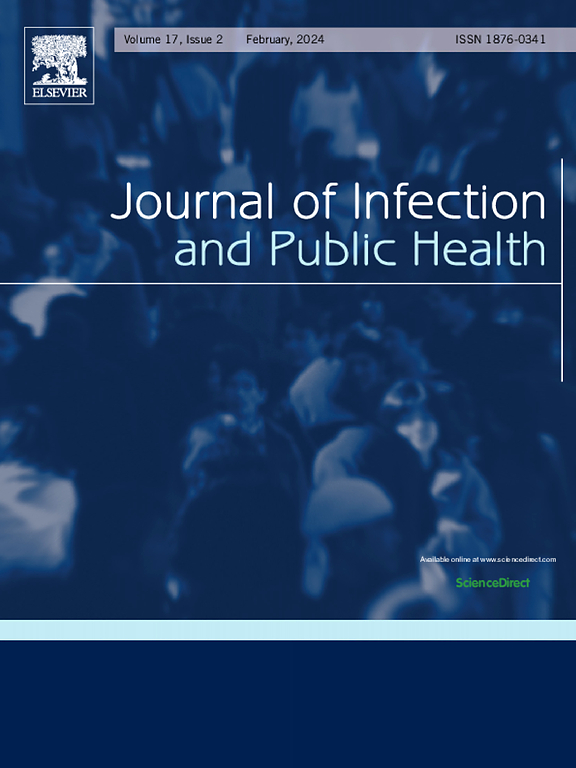携带药物外排泵和多个重复串联blaKPC-2核心结构的肺炎克雷伯菌临床多药耐药特征
IF 4
3区 医学
Q1 INFECTIOUS DISEASES
引用次数: 0
摘要
目的探讨含有药物外排泵和blaKPC-2核心结构多次串联重复序列的肺炎克雷伯菌临床多药耐药机制。方法综合分析SC7、SC35、SC38、SC41、SC42、SC67、SC173菌株的特征。该分析包括抗菌药敏试验、共轭转移实验以及β -内酰胺酶和碳青霉烯酶生产的检测。使用Illumina和Nanopore平台对这些菌株的基因组进行测序,以产生高质量的基因组数据。随后,利用生物信息学工具分析携带抗生素耐药基因的移动遗传元件。结果所分析的肺炎克雷伯菌菌株产生A类碳青霉烯酶,并对几乎所有测试的抗生素均表现出耐药性。这种抗性主要归因于外排泵基因的存在,如位于染色体上的acrAB-tolC。此外,这些菌株的基因组中含有一个或多个重复串联的blaKPC-2核心结构,以及blaKPC-2和/或blaCTX-M-65核心结构。一些质粒还携带blaSHV-12、blaTEM-1和rmtB。这些遗传结构与Tn3和TnAs3等可移动遗传元件相似。菌株SC67具有blaKPC-2核心结构的7个串联重复序列,这是一项新发现,显著推进了我们对抗生素耐药机制的理解。质粒转移试验表明,所有菌株均成功偶联,平均偶联频率不同。对携带blaKPC-2和/或blaCTX-M-65的全长质粒和多药耐药区进行比较分析,发现这些核心结构具有高度的进化保守性。结论这些菌株的进化与blaKPC-2和/或blaCTX-M-65的核心结构有着复杂的联系。此外,染色体上多个药物外排泵的存在显著有助于它们对几乎所有常用抗生素的耐药性。鉴于这些发现,必须制定和实施有效的战略来遏制这些高耐药菌株的传播和流行。本文章由计算机程序翻译,如有差异,请以英文原文为准。
Characterization of multidrug resistance in clinical Klebsiella pneumoniae strains carrying drug efflux pumps and multiple repetitive tandem blaKPC-2 core structures
Objective
To elucidate the mechanisms of multidrug resistance in clinical Klebsiella pneumoniae strains that harbor drug efflux pumps and contain multiple tandem repeats of the blaKPC-2 core structure.
Methods
The characteristics of strains SC7, SC35, SC38, SC41, SC42, SC67, and SC173 were comprehensively examined. This analysis encompassed antimicrobial susceptibility testing, conjugative transfer experiments, and the detection of beta-lactamase and carbapenemase production. The genomes of these strains were sequenced using both Illumina and Nanopore platforms to generate high-quality genomic data. Subsequently, bioinformatics tools were employed to analyze the mobile genetic elements that carry antibiotic resistance genes.
Results
The analyzed K. pneumoniae strains were found to produce class A carbapenemase and exhibited resistance to nearly all tested antibiotics. This resistance was primarily attributed to the presence of efflux pump genes, such as acrAB-tolC, located on the chromosomes. Additionally, these strains contained one or more repetitive tandem core structures of blaKPC-2, as well as blaKPC-2 and/or blaCTX-M-65 core structures within their genomes. Some plasmids also harbored blaSHV-12, blaTEM-1, and rmtB. These genetic structures showed similarities to mobile genetic elements like Tn3 and TnAs3. The identification of strain SC67, which possessed seven tandem repeats of the blaKPC-2 core structure, represents a novel finding and significantly advances our understanding of antibiotic resistance mechanisms. Plasmid transfer assays demonstrated successful conjugation in all strains, with varying average conjugation frequencies. Comparative analyses of the full-length plasmids and the multidrug resistance regions carrying blaKPC-2 and/or blaCTX-M-65 revealed a high degree of evolutionary conservation in these core structures.
Conclusions
The evolution of these strains is intricately linked to the core structures of blaKPC-2 and/or blaCTX-M-65. Moreover, the presence of multiple drug efflux pumps on the chromosomes significantly contributes to their resistance to nearly all commonly used antibiotics. Given these findings, it is imperative to develop and implement effective strategies to curb the dissemination and prevalence of these highly resistant strains.
求助全文
通过发布文献求助,成功后即可免费获取论文全文。
去求助
来源期刊

Journal of Infection and Public Health
PUBLIC, ENVIRONMENTAL & OCCUPATIONAL HEALTH -INFECTIOUS DISEASES
CiteScore
13.10
自引率
1.50%
发文量
203
审稿时长
96 days
期刊介绍:
The Journal of Infection and Public Health, first official journal of the Saudi Arabian Ministry of National Guard Health Affairs, King Saud Bin Abdulaziz University for Health Sciences and the Saudi Association for Public Health, aims to be the foremost scientific, peer-reviewed journal encompassing infection prevention and control, microbiology, infectious diseases, public health and the application of healthcare epidemiology to the evaluation of health outcomes. The point of view of the journal is that infection and public health are closely intertwined and that advances in one area will have positive consequences on the other.
The journal will be useful to all health professionals who are partners in the management of patients with communicable diseases, keeping them up to date. The journal is proud to have an international and diverse editorial board that will assist and facilitate the publication of articles that reflect a global view on infection control and public health, as well as emphasizing our focus on supporting the needs of public health practitioners.
It is our aim to improve healthcare by reducing risk of infection and related adverse outcomes by critical review, selection, and dissemination of new and relevant information in the field of infection control, public health and infectious diseases in all healthcare settings and the community.
 求助内容:
求助内容: 应助结果提醒方式:
应助结果提醒方式:


